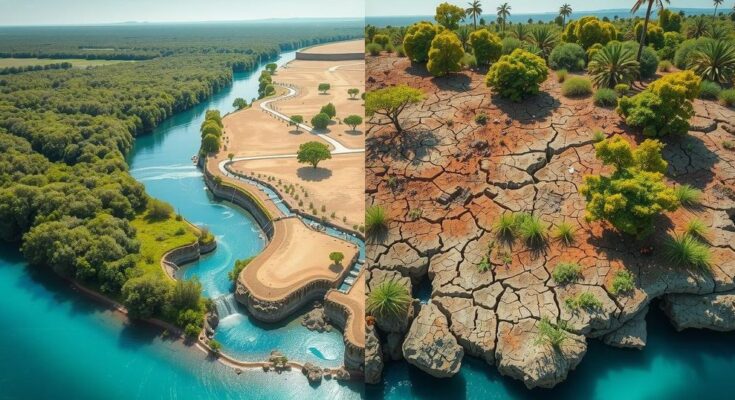A recent study in *Nature* reveals that climate change is widening water scarcity in some regions while improving conditions in others, underscoring the need for region-specific adaptation strategies. Countries like India face exacerbating water deficits, while Nigeria and Sudan may benefit from shifting precipitation patterns. Enhanced data collection and tailored policies are essential to address evolving water challenges globally.
A recent study published in the journal Nature highlights the unequitable distribution of global water resources, exacerbated by climate change, which calls for diverse adaptation strategies across nations. Countries such as India are projected to face worsening water scarcity, whereas others like Nigeria and Sudan might experience improved conditions due to altered precipitation patterns. This variability necessitates region-specific solutions and ongoing evaluation of water resource availability.
The increasing water deficits in specific areas raise concerns over potential conflicts, particularly in politically volatile regions. A report by the United Nations Convention to Combat Desertification (UNCCD) corroborates this by linking increased resource pressures to escalating disputes. Consequently, the need for localized policies and careful planning is paramount to mitigate these effects.
Quantified data is crucial for effective planning and response strategies. According to UNCCD, an overwhelming 93-95% of employment initiatives aimed at enhancing water security are occurring in the Asia-Pacific region, predominantly in India via the Mahatma Gandhi National Rural Employment Guarantee Scheme (MGNREGS). These efforts signify a commitment to water conservation, though the persistent narratives of water shortages in Indian cities raise the question of their adequacy.
The study, co-authored by Lorenzo Rosa and Matteo Sangiorgio, emphasizes the importance of quantifying current and future water scenarios for strategic planning. It identifies existing data on groundwater and environmental flow reductions but calls for a comprehensive assessment of past and anticipated water deficits to drive informed policy-making amid uncertainties.
Defined as the disparity between available water supply and demand, the concept of water gaps highlights varying deficits across regions. The research measures these deficits in cubic kilometers across significant hydrological basins and employs a multi-scenario approach using five climate models to analyze potential future conditions.
Utilizing a 30-arc minute resolution for enhanced detail, the study juxtaposes current global temperatures against various warming scenarios indicative of climate change’s potential impact. Areas in California, the Iberian Peninsula, and large parts of South and East India are projected to experience increased water stress, particularly under a 3°C warming scenario.
In regions that are currently resilient, such as Italy and North Carolina, deteriorating conditions are anticipated if the climate warms to 1.5°C. Conversely, nations like Saudi Arabia may witness reduced scarcity at this temperature, though similar challenges will emerge at higher temperature thresholds. The study illustrates that India faces a higher threat of water shortages compared to China, particularly due to India’s extensive reliance on irrigation.
Projected deficits suggest South Asia, particularly India, Pakistan, and Bangladesh, will be severely affected by water scarcity under all warming scenarios, implicating the necessity to sustain and expand existing water conservation initiatives. Proper groundwater management, sustainable farming practices, and the implementation of water harvesting systems can further alleviate these pressures.
Countries in Southeast Asia, including the Philippines and Vietnam, are anticipated to benefit from increased water availability and should capitalize on these opportunities with proper flood management strategies. In contrast, regions such as the Middle East and North Africa must similarly prepare for water crises, emphasizing sustainable resource utilization and proactive agricultural practices to avert water scarcity.
The research underscores the necessity for rigorous monitoring of climatic impacts and acknowledges the limitations of current models, recommending future studies to incorporate more comprehensive data validation to enhance predictive accuracy.
Climate change is intensifying disparities in water resource distribution worldwide, necessitating tailored adaptation strategies based on regional specificities. Significant efforts in water conservation, especially in nations like India, are being made; however, the persistent threat of scarcity calls for expanded initiatives and strategic planning. Sustainable agricultural practices, better water management, and rigorous data collection are critical to mitigate these challenges and ensure equitable water availability.
Original Source: www.downtoearth.org.in




